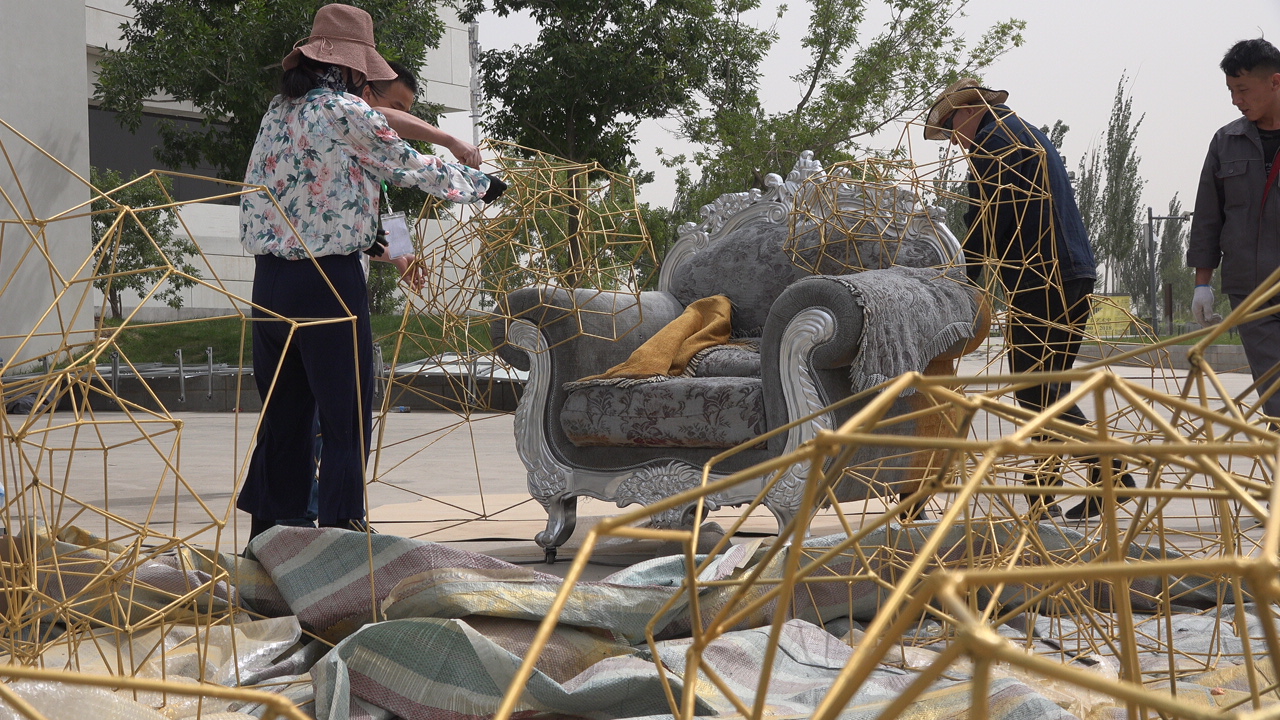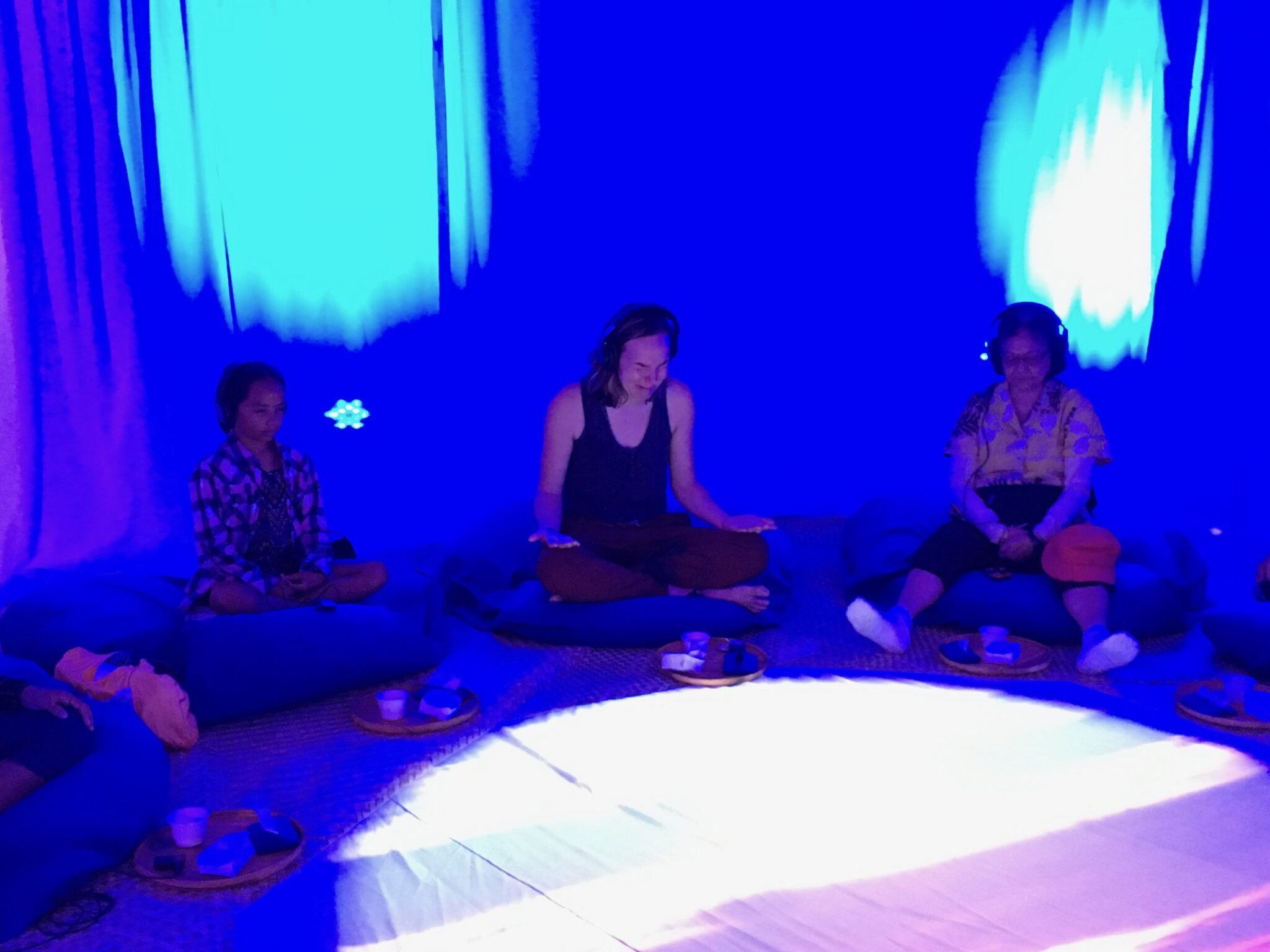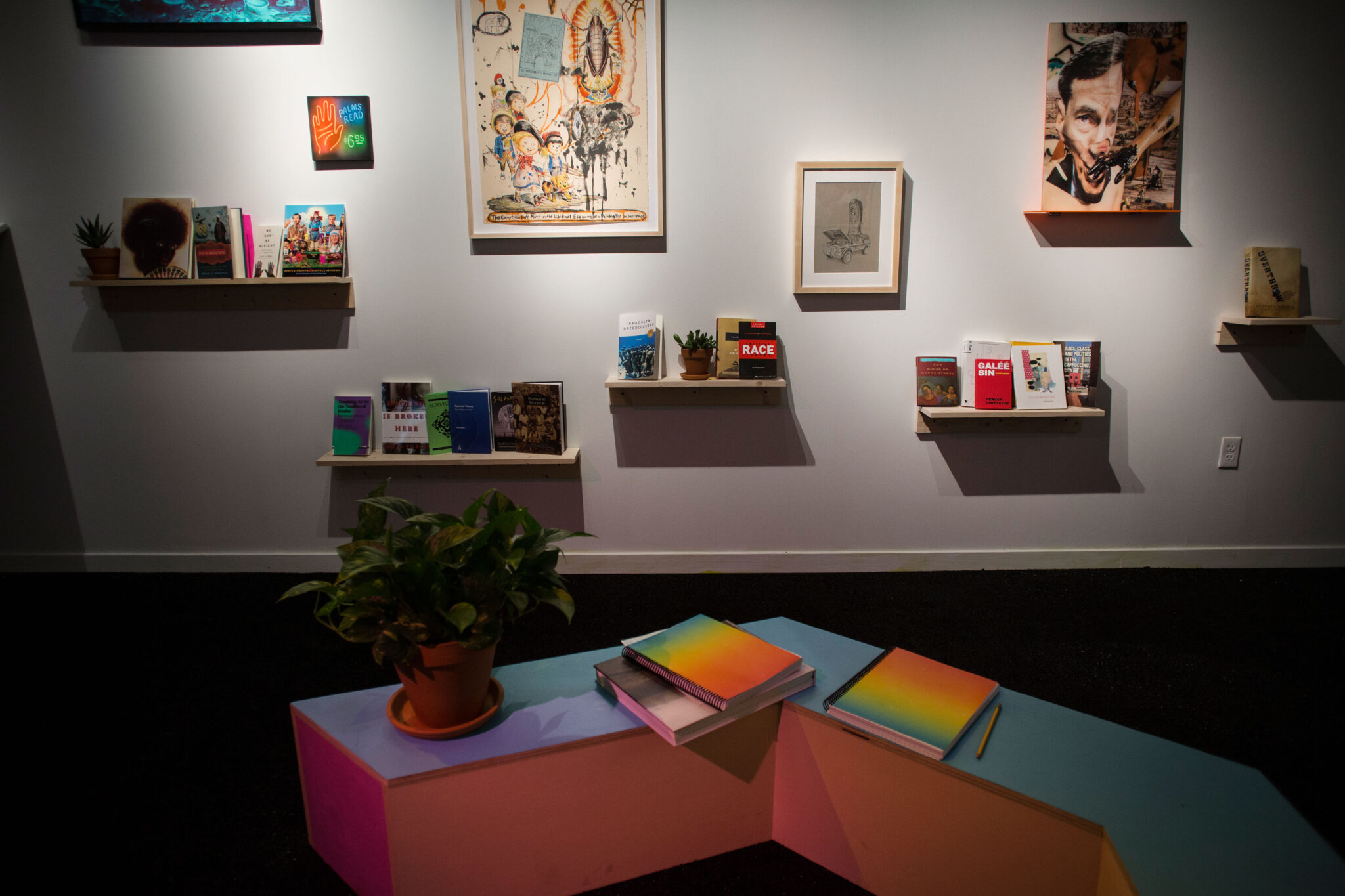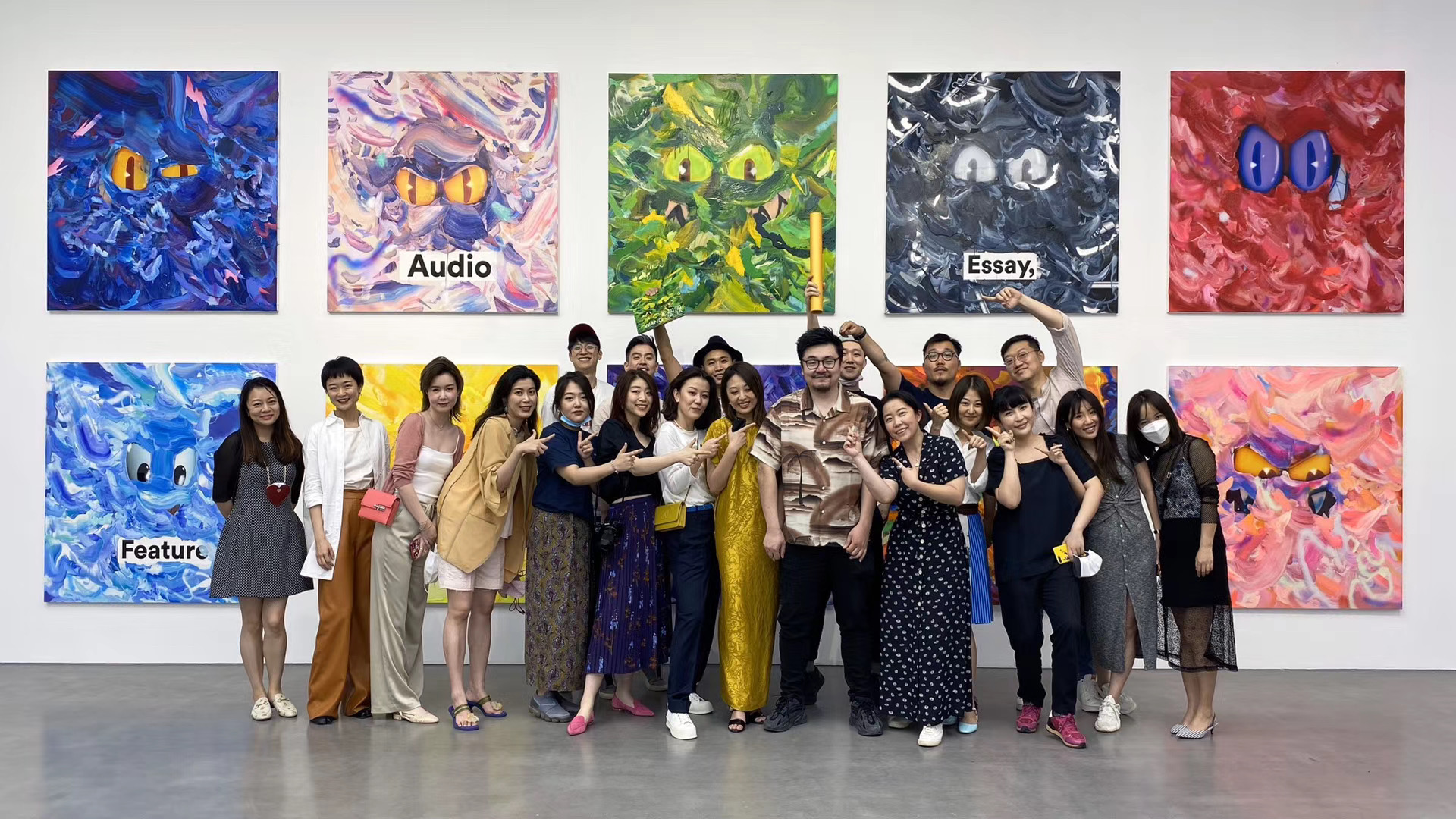同感地带 | Empathy Zone
采访一: 琳琳 x 尚子
Interviews I: Li LinLin x Naoko Wowsugi
采访二: 雅迪 x 乔瑟夫
Interviews II: Yin Yadi x Joseph Orzal
Facilitated and Translated by Althea Rao
Forewords Written by Yuzhuo Mark Zhang
♦
采访一: 琳琳 x 尚子
Interviews I: LinLin x Naoko
琳琳和尚子的在对话中找到了很多共鸣, 但在表达的方式和形式上有所区别, 这大概是由于成长环境、文化背景和语言的差异导致的。例如, 尚子在“眼泪主义”中的冥想过程, 李琳琳理解联想到了禅宗和修行。李琳琳的许多大型作品由非北京户口的外来工人协助完成, 尚子则联想到她的超本地化社群参与性项目。两位艺术家作为女性, 也对女性在日本, 中国和美国的生存状态和自我定位进行了探讨。
李琳琳在与尚子线上对谈时, 正随团考察中国江西抚州的乡村, 处在从–个地方辗转至另–个地方, 间歇性上下车和停留的奔走状态。而这种状态似乎也是全球的社会节奏不断加快, 时局不断变换的–个缩影, 在这样–个为生计奔波拼搏的社会中, 忙碌成为了常态, 风云变化成为了司空见惯。
Linlin and Naoko found many common threads through their conversations. They grew up in different cultural environments and speak different languages, and their ways of expressing themselves and describing the same subjects are also different. For example, when Naoko brought up using meditation in her work Tearism, Linlin thought of Zen and Buddhism. Many of Linlin’s works were constructed intentionally in collaboration with marginalized migrant workers in Beijing, and Naoko thought of her hyperlocal approach when creating community engagement through her work. As women, they also exchanged their thoughts and experience on being women in Japan, China, and the U.S.
Linlin was visiting the villages in Fuzhou, Jiangxi when she took the call. On camera, she was constantly moving between the bus and the ground, from one place to another, from a state of action to a state of seating. This encapsulates a larger state of being that our society has normalized: the pace of our life has accelerated, and we are busy and multitasking all the time.
参与式艺术, 交换和社群
Participatory Art, Exchange and Community
尚子 Naoko:
从二零一六年起, 我特别注意, 尽量和Hyperlocal的社群、人民和文化合作来进行研修和创作。当我对当地文化进行研究的时候, 我特别喜欢的自然地理。有–个学科叫做Bioregion–你会从当地的自然地理环境开始入手, 研究这些自然地理条件是如何影响了当地人类的生活和文化。我在和超本地化社群合作的时候很想将他们的文化放在高光之下, 而这种生物区视角的研究对我的创作过程很有启示。
这个兴趣, 也算是我对城区地价上涨导致的人口和产业迁移的–个回应。当我开始研究艺术领域中的资本主义, 美国的当代艺术工业是如何盲目的崇拜纽约的商业画廊–我的回答是, 这不是我想要的。很多由于地价上涨而被迫进行人口和产业升级换代的城市和地域, 原生的历史文化几乎被消磨殆尽。我想用我的艺术创作去重新赋予这些地域和居民力量, 让他们焕发生机。从这个角度看, 我和琳琳的创作是有共同点的。
Since 2016 I have been intentionally working with hyperlocal communities, extending my research around local cultures to make my work. When researching local communities, I always find that local nature is inextricable from the locale’s charm and history. There’s a study called bioregion–looking at the geographic map by nature and how nature affects the livelihood and culture of its people. A bioregional approach to the research inspires me to celebrate the uniqueness of a community on every scale.
Part of this interest comes from learning about gentrification. A hyperlocal approach is one way to combat the capitalistic system that creates a false sense of a singular center. Instead of assimilating into a homogenous society and aesthetic, I ask us to recognize all the histories and cultures of our immediate surroundings.
A lot of places are facing gentrification–I feel they are losing the identity of who they are. I use my art project to highlight who they are, and I see the common thread of empowerment between my work and LinLin’s.
琳琳 Linlin:
我很认同尚子的观点。我的工作室也在村子里。我对古建筑, 木头的颜色, 樟树的香味很感兴趣, 对人们生活的状态也很感兴趣。我在创作的时候, 不考虑作品的销售, 对于作品是否适合艺术市场和画廊运作规律都不考虑。我更希望作品能和人, 生活, 环境发生关系。
I agree with what Naoko said. Hyperlocalism–I care a lot about local people and villages too. My studios, when I was in school as well as now, are very close to the suburb. I am fascinated by old architectural structures, buildings, materials especially the color and scent of wood. I am also interested in the way people live their lives. When I create, I rarely think about sales of artwork, or how would this work fit in the art market or gallery scene. I am more interested in having my work be in conversation with people, life and the environment.
尚子 Naoko:
我的创作大都是参与性的。参与性创作则充满了不确定性, 而这正是我喜欢的。这就好像人生–样。他人自愿前来参与我的作品, 自己决定他们要做出什么样的反应, 然后他们的参与变成作品的–部分。我也很重视在我和参与者之间“交换”的概念。我希望他们能真实的从我的作品里有所收获, 而不是说他们只是单纯的来帮我完成我的作品。
因此对我而言, 我很看重对合作者的选择。每次在实施作品之前, 我会花至少几个月的时间对当地进行考察, 进行多次实地调研访问。在作品完成之后, 我会继续与当地居民保持联系。于我而言, 这是–个需要用–生去践行的承诺和长期的互惠关系。因此, 我和谁合作, 创作什么主题, 在选择的时候每次都是–个很重大的决定。
Participatory art plays a substantial role in my practice. Participatory art is full of unknowns and I like that. It’s like life practice. Local community members become participants in my work and are invited to react however they naturally do. This mutual exchange between me and the participants is of utmost importance. I want there to be something they can take away from my work, rather than the idea that they are just here to help me complete the work.
Therefore it’s important for me to be accountable to communities that are open to developing a relationship. I spend at least a few months before I execute my project. I visit them a lot. Even after the project is finished, we often continue to be in touch.
琳琳 Linlin:
这让我想到我在北京创作的经历, 做大体量的作品时会雇很多的工人。我觉得和师傅们–起创作的过程也很有趣, –方面, 作品实现了自己的想法, 与当地的结合, 给人们带去感受等等。另–方面和师傅们的合作是–个过程, 我可以找到–些资金, 他们又能通过自己的劳动养活自己的家人, 这样很有意义。
现在中国国内乡村很多地方都有艺术家驻留项目。每个乡村都有其独特的, 比如南北方不同的植被, 建筑风格都是不–样的, 都希望有艺术家结合当地。这两天, 我就是在考察江西抚州的乡村, 看–下这边的城镇和乡村能否和当代艺术有融合。我也是第–次来。虽然从小就在中国长大, 但也有很多没去过的地方。正好也可以带你看–看, 我现在所在的地方是寺庙。
我希望自己能做–些公益, 比如中国留守儿童, 贫困乡村, 我看到有–个公益项目叫“–个鸡蛋的力量”。我们可能无法想象有的孩子每天连–个鸡蛋的生活质量和营养都保证不了。我希望能为周围的人, 或者为社会能够带来–些帮助, 这也很有意义, 通过我力所能及的方式能为周边带来–些改善。
This reminds me of my experience creating work in Beijing. I hire many migrant workers from the local area to help me produce the work. On the one hand, I create works to realize my vision, to collaborate with local cultures, to bring an artistic experience to people. On the other hand, this gives me an opportunity to collaborate with the migrant workers, as I usually have a budget for manufacturing and can pay them wages for them to support their families. This to me is meaningful. This echoes what Naoko said.
These days, many Chinese towns and villages are eager to host visiting artists. Every place is so unique–the plantation, architecture and aesthetic styles can be drastically different. They all want artists to work with their local culture specifically. Today I am visiting the villages in Fuzhou, Jiangxi Province. Peking University organized this trip. We are hoping to see if local townships and villages have the potential to become artist residencies and be involved more with contemporary art. This is my first time here. Although I grew up in China, still there are a lot of places I haven’t been to. This might be a good chance to show you some of these local Buddhist Temples.
I want to do some charity work, or involve charitable acts in the work I do. China has a lot of left-behind children in the rural area and countryside of extreme poverty. There is a charity project called “The Power of an Egg”–can you imagine that, some children in China cannot even afford the lifestyle and living standard of an egg a day? I want to be able to contribute to people and society, and bring positive changes to my surroundings through the work I do.
The production process at Yinchuan Contemporary Art Museum for Li LinLin’s exhibition: RECONSTRUCTION SERIES–MY SONGS FROM HEART, 2019
禅修, 冥想和艺术 Zen, Meditation and Art
琳琳 Linlin:
我在尚子的作品中感到禅修, 宗教和佛在里面。冥想这个词可能是从国外来的吧?尚子怎么理解冥想呢?
I felt “zen” in Naoko’s work–something religious and Buddhist feeling. Has the word “meditation” originated from the Western world? What do you think of meditation?
尚子 Naoko:
我第–次冥想是在夏威夷, 做“眼泪主义”项目的时候。我只有四个月的时间去当地考察, 研究, 然后就要展览。所以我很紧张, 不知道能不能在这么短的时间内找到灵感。我的朋友说, 你不然试–试冥想吧。我就尝试了–次, 然后就这样有了“眼泪主义”的点子。我从此对冥想变得很感兴趣, 然后这个兴趣促使我在作品里也不断重复使用它作为–种手段。
The first time I ever meditated was in Hawaii where I ended up creating Tea(r)ism. I only had four days to be there for research before I had to submit a proposal for the exhibition. I was nervous about coming up with an idea, and my friend suggested I should try meditation. On the first try I got the idea for Tea(r)ism. This experience has led to a long term commitment to meditation.
琳琳 Linlin:
尚子可以讲–讲你的眼泪主义和鲜味体验中心项目吗?
Can you talk a bit more about Tea(r)ism and Umami Taste Development Center?
尚子 Naoko:
昨天的时候, 我忽然想起来, 我小时候是很想研究中国的茶文化来着。我也很喜欢茶道仪式。在“眼泪主义”这个项目里, 我能看到当年这个兴趣的影子。我是2017年创作的“眼泪主义”项目, 然后2018年创造了“鲜味体验中心”。在“眼泪主义”里, 人们前来–起冥想, 然后流泪。这是–个16分钟的体验, 我希望可以给人们带去净化洗涤的效果。
对于“眼泪”, 我进行了很多研究, 因为我想通过这个作品馈赠于参与者–个真挚的净化体验。我研究了眼泪的功能和益处, 流泪如何能够增强知觉从而引发净化, 等等。我在研究中学到, 当–个人冥想, 他大脑皮层的某处会被激活, 让人进入–种专注的心无旁骛的状态, 这和艺术创作的时候, 人能达到的那种专注和心无旁骛的状态是相似的。我在作品里, 会有意识的使用艺术创作和冥想来帮人达到净化和高度专注的状态。
While preparing for this interview I was reminded of my desire to study Chinese tea when I was a teenager- I have always liked tea ceremonies. In retrospect, I see the connections between my interest in tea and Tea(r)ism. I made Tea(r)ism in 2017. For Tea(r)ism, people were encouraged to cry throughout the meditation. I hoped this meditation would provide a real cleansing experience for the participants.
I researched the function and benefit of tears; how crying can bring awareness and provide catharsis. I also learned that meditation stimulates certain parts of your brain which makes you enter a focused state. Combining both into this participatory project created a synergy that led to an ultimate cleansing.
琳琳 Linlin:
我在创作的过程中, 比如缝–块布, 缝布料的过程和那种专注的状态, 其实和冥想是差不多的, 都是沉浸在作品当中, 在作品中很沉静很安静的把事做好, 把–块布缝好。也像是达到了冥想的状态。
When I am creating, such as adding stitches to a piece of cloth–that process feels similar to meditation. Both are highly focused on the work, immersing myself into something and doing the work with all my attention, even just adding stitches to a piece of cloth. To me, that’s meditation.
Naoko Wowsugi’s participatory performance: Tea(r)ism. Launched in 2017, Honolulu, HI. Hosted by the Smithsonian Asian Pacific American Center.
女性, 童年和意识形态 Womanhood, Childhood, Identity
尚子 Naoko:
你作为–名女性当代艺术家, 在中国是怎样的生存状态呢?
How is it like being a contemporary artist in China as a woman?
琳琳 Linlin:
我父母离婚是因为我是个女孩。我父母离婚的时候是九几年–现在在小地方, 农村还是重男轻女的。还是想要–个男孩。他们骨子里从过去到现在–直都有的重男轻女的现象。 我作为女性, 因为有孩子, 兼容家里孩子的事情, 教育, 家里人的生活, 我自己的生活和创作–其实是很艰难的。我觉得在夹缝中生存的感觉, 透不过气来。
在国内有很多女性艺术家不强调自己是女性, 也不愿意让别人说自己是女性艺术家。也有人希望强调自己是女性艺术家。我在创作做作品的时候不考虑自己是什么性别, 比如做体力活或者受伤, 这些都是提前预料到的有可能会发生的, 就什么都不怕, 就做了–比如在创作的过程中或者当作品完成之后, 不管别人对我有什么意见, 这些其实都是已经预想到的, 总体来说, 社会主体是由人组成的, 人都有自己的特性, 比如人性中的嫉妒或者–些好的不好的, 这些都是人所具有的本性, 是应该有的, 当理解这些都是人类本该有的正常现象和反应的时候, 我会去接纳, 也就感觉没什么了。
My parents became divorced because I was born a girl. That was in the 90s. Even now, in rural Chinese places, families still prefer sons over daughters. This “male-centric” cultural phenomenon hasn’t changed all that much. As a woman and mother, I have to attend to general house chores, take care of my two children and their education, cook for other people in the family–all of these on top of my own life and studio practice, making my life extremely difficult. Sometimes I feel like being sandwiched between so many things and have little room to breathe.
In China, many womxn artists don’t want to emphasize their gender and hate people calling them womxn artists. At the same time, some do like wearing this label a lot. As for myself, I don’t really think about my gender when creating works. I do a lot of physical labor, get injured–I have expected all of that, so there’s nothing to fear. Some people attack me and my work. I’ve considered that as well. Perhaps it’s all part of humanity, things like jealousy and greed. If I see them as “this is how things should be” and try to accept that, it doesn’t feel as personal or worth feeling bothered by.
尚子 Naoko:
能够这样想真的很强大。你在作品里自由运用大和小的体量, 你有两个孩子–无论怎样的挑战和阻力, 来自社会或者个人–你的努力会给未来的艺术界带来希望, 不光是为女性, 而是为所有人。我们通过艺术创作, 可以开辟新的道路, 提供积极的可能性。
I think that’s really strong. Your ability to create from massive, immersive installations to more intimate, delicate sculptures is really impressive. On top of that you are a mother to two children. It is no easy feat to be a female artist and mother in the art world, but I’m certain that your perseverance and example will benefit everyone. We have liberated our own creative practices in spite of the limitations and expectations put upon us as womxn artists. In doing so I think we have been expanding positive possibilities for future generations.
♦
采访二: 雅迪 x 乔瑟夫
Interviews II: Yadi x Joseph
乔瑟夫和殷雅迪都是画廊从业者, 目前也都都身兼数职—艺术家、策展人、画廊主, 艺评人、特约艺术撰稿人。乔瑟夫 曾把华盛顿哥伦比亚特区的自家经营成一House Gallery, 后因房价上涨不得已放弃。他的新画廊NoMüNoMü 在地价相对低廉的邻市巴尔的摩。殷雅迪在画廊和非营利机构都工作过, 有知名的大型艺术机构, 也有像相对独立的艺术空间, 她现在是SPURS马刺画廊的从业人员。两位艺术家都有过因为生活成本上涨及经济压力, 换工作、换城市、换出租房的经历。作为城市的艺术打工人, 他们对于旧城区改造的城乡迁移、物价上涨、资本入侵现象, 都有着不同的感受以及共鸣。雅迪和乔瑟夫 身处异地, 不曾到过彼此的城市, 也不曾亲身看过彼此的项目。他们前期的对话和对对方艺术创作的解读, 是基于自己的视觉经验和知识结构对图像进行理解和阐释。本次的直接对话, 让他们能够实时沟通, 不加修饰、不带过滤地了解彼此的创作和策划理念。
Joseph and Yadi are both gallerists. At the same time, they are also artists, curators, gallery owners, art writers and critics. Joseph once operated a house gallery out of his home in DC. He had to give that up due to the rising house price. His new gallery NoMüNoMü is now in the adjacent city Baltimore, where the art scene is booming and prices are cheaper. Yadi has worked at both commercial galleries and nonprofit organizations, including big name institutions and indie spaces. She is now a staff member at SPURS Gallery. Both artists have experienced economic impact from the rising prices of urban environments, having to change jobs, change cities, and change apartments. As urban dwelling art practitioners, they both relate to phenomena such as gentrification, inflation and capitalism but from different angles based on different personal stories. Yadi and Joseph are based in different cities. Neither has been to each other’s city nor witnessed each other’s work in real life or real time. Their email exchanges are based on interpreting visual documentations of each other’s work. This conversation provides an opportunity for them to connect directly in real time, to learn about each other’s creative process and conceptualization without filters.
“乐观主义佛教徒”是在示弱吗?中国和美国的城市病
“Hedonist Buddhist” and Victimization: Gentrification in Chinese and U.S. Contexts
雅迪 Yadi:
讲一讲“乐观主义佛教徒”这个项目吧—我很感兴趣。
Can you talk a bit about “Hedonist Buddhist” and your work about gentrification?
乔 Jo:
我是在华盛顿哥伦比亚特区一个不太富裕的家庭出生长大的。当城市的地价上涨, 我们家也被影响了, 没过几年就不得不搬到租金便宜一点但偏远的地方。我也看到这个现象的普遍性, 很多人都被迫搬离家园。由于地价上涨所导致的人口迁移完全改变了我周围的城市景观。
I grew up in DC–not from a very rich family–we were affected by how housing prices rose and we had to leave after a few years. I started to see gentrification happening pushing people moving outside of DC–completely changed the landscape of my home.
雅迪 Yadi:
我本身出生在疫情的发源地武汉, 到北京也算外来人口。你观察到的现象其实比较普遍。但是在北京, 我朋友和自己作为所谓的打工人, 在面对物价上涨更多会想到通过更长的工作时间, 增加收入来源来应对, 而非将此作为议题。“乐观主义佛教徒”项目, 来看的人群是怎样的, 收到了怎样的反馈呢?
I was born and raised in Wuhan, where the pandemic started. Coming to Beijing, I am technically a migrant.The gentrification you described is quite universal and I’ve observed similar things in my network and neighborhood. Yet in Beijing, my friends and I consider ourselves “salary people”. When faced with inflation, we would want to increase our work hours and overall income to maintain our living standard. We haven’t thought of creating an artwork to form discussion around it. For “Hedonist Buddhist,” who were the people coming to see the project, and what kind of feedback did you receive?
乔 Jo:
这个项目的本意是站在财富的对立面。所以当人们刚开始来看展览的时候, 气氛还是有点尴尬紧张的—大部分走进展区的人一开始都以为这只是个商店。不过, 展览的内容的确帮助人们意识到他们其实也是城区改造, 人口迁移现象的参与者和“帮凶”。至少有两个人, 在看过展览之后搬离了他们居住的住宅小区, 其中一个人特别是因为我们的展览而做出的决定。
项目的另外一个重点在于, 邀请来自不同社群的艺术家和积极分子来相聚于一个舒服的, 开放的环境。在这方面, 很多人都对这个空间的存在感到高兴。在华盛顿哥伦比亚特区还是很难得的。
The show was meant to confront the wealthy. So there was a lot of tension that happened between the people walking in. It wasn’t very hostile. But people mostly walked in and thought it was just a store. It did help some people understand what they were doing–at least 2 people moved out of the condominium. One specifically was because of the show.
Another point of the project was to bring in activists and artists from different communities to come in–from that level it was well received–a lot of activists were happy that they were able to meet at a very comfortable space consistently as it was hard to do in DC.
雅迪 Yadi:
有人因为看展览而搬走的行为—很有意思。我一直觉得可能在华盛顿居住的人们只是因为巧合, 有的人生来占据了更多的资源, 有的人恰好没有, 没有占据资源的人不得不从中心迁移到边缘地区。但是“乐观主义佛教徒”对此释放的态度是阶级对抗吗?会不会有示弱的嫌疑?
It’s quite impressive that some people decided to move because of what they had learned from the show. However, my understanding is that the residents of DC were divided into class by accident–some are born with more resources, and some without. Unfortunately the people with less social resources have to move away from central locations. Does “Hedonist Buddhist” interpret this phenomena from a perspective of class confrontation? Is there a risk of “victimization”?
乔 Jo:
我不认为这是示弱。这不是一个廉价的展览。我费了很大劲儿, 筹了两万美元才将这个展览呈现出来。展览里展出的有很多关于系统性压迫的史实的书籍。是的, 在哥伦比亚特区的确存在阶级分立。如果我们谈年薪三万和年薪十万的分立, 这还是比较正常的。然而如今我们讨论的是一小部分百万亿万富豪在基本不挣什么钱的穷人头顶作威作福, 这是非常极端的不平等。至于“示弱”——我们做这个展览的目的并非去乞求帮助。我们只是想在主流的社会现实中开辟我们自己的一片净土, 让志同道合的人可以相聚, 畅谈, 讨论如何能够改变不公平的现实而让社会变得更以人为本和宜居。
It wasn’t victimization because for me it wasn’t a cheap show. I had to raise 20k to make the show happen. And what we were presenting in the show was a lot of books that pointed to historical facts that were about systemic oppression. What we were pointing to was–yes there is class division in DC. In DC, it’s more normal like people were making 30k here and 100k there–it’s more stratified, but DC has become like people making millions now living on top of people making under 50 and we were pointing to the drastic inequality here. As far as victimization goes–I wouldn’t–we weren’t asking for help, we were just making our own space for people to meet in, and telling them that it’s a fucked up situation and we have to take measures to make a statement against and most importantly make spaces for ourselves.
Hedonist Buddhist took place in 2019, at the Washington Project for the Arts, D.C.
艺术创作, 未来和成长 Art Practice, Future and Growth
张雨卓Mark:
你们在艺术家、策展人、画廊经理人、活动家这几层身份之间游走。这种状态如何影响了你的作品?
Running and working between different roles–artists, gallerists, activists–how does that affect your work?
乔 Jo:
这些其他的身份说实话, 给我从事艺术创作造成了阻碍。NoMüNoMü 刚刚创办的时候, 是作为一个平台, 让我和我的朋友们可以在上面搞创作。随着这个项目逐渐长大, 我的创意性投入逐渐变少, 而行政和管理的工作却越来越重。现在, 回归艺术家身份进行创作反而是最难的。想来, 好像过去的两年我和艺术创作都是脱节的。
These roles are getting in the way of me making art. NoMüNoMü started as a platform for my friends and myself to make art. As it developed, my creative input became less and less and I kinda took a director role. Now the hard part is going back and making my own art–I feel that I’ve been just out of practice for like two years.
雅迪 Yadi:
我能理解这种感受。每个人的时间精力有限而必须有所取舍。但我不认为只有作为艺术家的身份可以体现创造力。你所做的所有事情都需要调动各种资源和天赋。某种程度上这种焦虑感或许能帮你找到最合适的状态。
I can relate. We all have limited capacity and once we gain something, more than likely there are things that we have to give up. However, I don’t think being an artist is the only way to be creative. Everything you do involves your talent, resources and creativity. Perhaps the anxiety you are feeling can actually help you find your most comfortable way of existing.
乔 Jo:
你能谈谈你写的那篇“艺术工业里不能直说的秘密”的文章吗?
I want to know more about the collector article–curious about this collector’s article that you wrote: Secrets those in art industry that can’t be said straightforwardly.
雅迪 Yadi:
现在回看这是2016年我作为一个刚从国内美术学院毕业的学生, 刚开始了解画廊机构, 策展人, 艺术家的比较浅显的观察。我现在觉得还挺惊讶的—我现在已经不会这样思考了。当时的想法更直接。我现在可能需要重新找回这些遗失了的东西。
I wrote this article in 2016 when I just graduated from the art school. I was getting to know how normally galleries, curators and artists operate and wrote down my simple observations. Revisiting this article I felt quite surprised by how straightforward my thought process was–I feel that I am no longer able to think this way. Perhaps I need to reclaim the things I’ve lost.
乔 Jo:
你可以谈谈你失去的东西吗?
Can you elaborate more on the things you have lost?
雅迪 Yadi:
可能每天都在得到, 但每天也在失去吧。在你还没有进入行业的时候可能对艺术会有一些想象, 来自于你对一些个人或者世界的一些期待, 但可能并不是真实的。对我来说真正进入了所谓的艺术世界之后, 自己最初对此的期待, 甚至对自己的期待, 都有一些模糊。这可能是我目前的状态。
我有从书上看到人成长的不同阶段, 当你解决了自己的问题之后, 可以投入社会实践。我很尊敬你的作品, 因为你将个人问题放在社会语境里, 包括帮助其他的青年艺术家。我目前的状态可能还是独善其身。我所在的文化艺术行业是一个需要知识输出的行业— 通过文字影像表达。前提是你有所经历, 体会, 有所储备。我一方面置身在一个比较商业化的画廊里, 另一方面又想要提醒自己我的储备还不够, 但这也是两面去看—有的人会说不一定要你准备好了才可以开始做一件事情。
Well, perhaps I am gaining something new every day while losing something at the same time. Before entering the art field I had certain imagination about what art was, how art should be. These impressions are projections of my own personal expectations and world views. They might not be true. Once entering the field, all of these impressions and expectations felt blurred, which captions my current state of mind.
I read that there were different stages of personal growth. Once you’ve met your personal needs and goals, you can devote yourself into social practice. I respect your work for this particular reason, as you situate your work in the context of the society and are committed to help other young artists. I am not there yet, still need to prioritize attending to my own problems first. The art and cultural industry requires a lot of output of information and knowledge–via texts, visualizations, etc. To be able to output, one has to have rich life experiences and reflections, a strong base. On one hand I work at a commercial gallery; on the other hand, I don’t think my foundations are solid enough. However, perhaps one could look at this differently–some people might say that you don’t have to be super ready and perfect in order to start doing something.
乔 Jo:
你想开始做的事是什么呢?什么媒介?
What do you want to be doing? What medium?
雅迪 Yadi:
明年我们画廊会有一个自主策划的展览。我会以策展人的身份策展。受众依然是画廊本身积累的受众, 我所工作的画廊是一个平台, 在吸纳它所代表的品味, 藏家的审美趋势, 甚至是中国的二代或者三代社群。很多时候观众决定了实践的内容, 要怎么样想象观众才会有对应的内容。我在其中作为一个工作人员一方面要和老板圈子的人交朋友, 但另一方面我又觉得无法真正融入他们。我觉得我应该也是在想象我未来的观众—和什么样的一群人为伍——具体是什么样的人, 还在寻找。
Next year I will be curating a show at the gallery I work at. The audience most likely will still be the existing audience of the gallery–the gallery is a platform that represents the tastes and aesthetics of its audience and collectors, many of them are rich people and wealthy kids. In many cases, these people’s preferences define the framework of the gallery’s art practice, and we need to consider what content to provide based on our understanding of who will be consuming. As a staff member, I have to interact and make friends with this group of people, at the same time I still feel it’s hard to really become part of them. I guess, I am also trying to picture my future audiences and the groups I will be part of in order to come up with proper output. I still don’t know what that will be.
Opening reception for the artist, Wang Jiajia at SPURS gallery, where Yin Yadi curates.
独立艺术,政治与规
Independent Art, Politics and Human Scale
乔 Jo:
中国的艺术市场和美国的是不是很像?有没有很多有钱人?
Is the art market in China similar to the U.S. market? Lots of rich people?
雅迪 Yadi:
这是必然的—当代艺术本身就是一个西方体系下的产物, 资本主义的产物。现在世界上任何一个角落都没有办法脱离这个情景讨论。他之前提到的贫富差距, 在国内可能更明显。
Rich people–it would be hard to avoid. Contemporary art is a product of the Western framework, of capitalism. Nowhere on the planet can escape this context. The class division and wealth gap you mentioned earlier might be more prominent in China.
乔 Jo:
我挺想看一看中国的艺术家和他们的创作。我们要怎么样才能跨越文化的限定讨论美学呢?对此我很感兴趣。我自己还不知道这会是什么样子, 因此很想了解人们已经在从事的内容。
I do want to know some artists to look at. I’m very interested in how we can start to articulate aesthetics of cross cultural dialogue–I’m not sure what that should look like but am eager to see what people are doing across the world.
尚子Naoko:
和商业性的艺术相比, 以社群艺术为发展趋势的当代艺术更注重伦理道德, 尤其当我们作为艺术家与社群中的普通人合作创作作品的时候。同感地带的这个项目所促成的两地艺术家一对一对话是没有政府干预的, 因此艺术家本身能有更直接和真实的作者身份。
Compared to commercial art, social practice and contemporary art practice is more ethical, especially when we work with communities. The work we are doing at Empathy Zone–facilitating direct conversations between artists from different cultures without government facilitation or interruption–artists can have a more direct role.
雅迪 Yadi:
泰康空间有一个谈论历史的展览—胡浩在梳理中日史料的时候发现在战役之余, 没有进入战争状态的时候, 士兵会处于一种交流的状态, 站在一起抽烟。这恰好说明了这个正式与非正式交流的问题—国家是我们想象出来的, 但我们个体之间的交流是可以持续的。我们总会去面对差异性, 但是寻找到和自己相近的人好像又总是一种趋势。Joe, 我知道你作为独立艺术家, NoMüNoMü 作为独立机构很强调独立性。是否独立性总是与所谓的边缘为伍呢?
There was an exhibition at Taikang Space about history. When combing through historical facts on the war between Japan and China, the curator Hu Hao discovered a lot of documentation of individual Chinese and Japanese soldiers hanging out together, chatting and smoking cigarettes–when they are not in fighting mode. This actually illustrates this contrast between “official/national” way of cross-cultural interaction and the “casual/individual” way of exchange. The concepts of nation and country are constructed, but our exchange on an individual level and human scale is natural and part of our instinct. As individuals, we all have to deal with differences, but we will always end up finding groups of people who we share common traits. Joe, I know you are an independent artist and NoMüNoMü is an artist-run independent organization. Do you think being independent means being radical and marginal?
乔 Jo:
不是这样的。找到这个平衡不是很容易。艺术创作就是突破传统美学—尤其是可以被市场营销的美学。我们最初创立NoMüNoMü 来代表我和我朋友的作品, 就是因为他们的作品不被主流商业性画廊所欣赏。我们作为独立艺术机构的本意不是政治性的, 而是更侧重于作品。然而随着发展, 这个项目变得高度政治化了。其实我觉得所有的艺术都是政治的。艺术市场则尝试给作品去政治化。这是有问题的。
No. I think this is where I am–the balance is difficult–doing art is trying to break out conventional aesthetics, marketable aesthetics–NoMüNoMü started as a way to show my friends’ work because they weren’t getting any gallery representation. So it wasn’t very political–it was about the art–but it became political. I think all art is political. I think the market tries to depoliticize the work. I think that is the problem.
雅迪 Yadi:
我和艺术的结缘其实也经历了很多不同阶段—我也会想难道一辈子就要和所谓的艺术打交道了吗?世界上还有很多别的有意思的事情。有时候也会感到疲惫。艺术本身或许和艺术品都没有太大关联, 艺术终止于艺术家完成作品。但可能后来觉得需要调整的是自己的状态, 就好像人除了做自己之外也没有别的选择—当我认清了这一点后更多的就是接受和找到自己的方式。在不同身份间切换, 不同的视角可以让我了解到更多元的世界。另外我觉得所谓的当代艺术非常有魅力的一点事, 他成了世界的一个切面, 能承载的太多了, 发生的一切都可以囊括其中—回应所有的艺术都是政治性的—艺术也可以承载知识吧。
My relationship with art has evolved through many stages as well–sometimes I think, am I really going to be in the so-called art world for my entire life? There are so many other interesting things in the world. Sometimes I get tired–it seems like art, artifact, and artwork are all operating on their own orbit with little cross path. The process of art is terminated the moment the artist is done creating. However, later I realized that, I need to adjust my attitude. We can only be ourselves. There are no other choices. Once I came to this understanding, I began to learn to accept myself and find my own way. Switching between different roles, adopting different perspectives, allow me to look at the world in a more diverse way. Contemporary art provides different section drawings of the world. There is a lot to contain. In response to “all arts are political”–I think art can bear knowledge too.
♦






